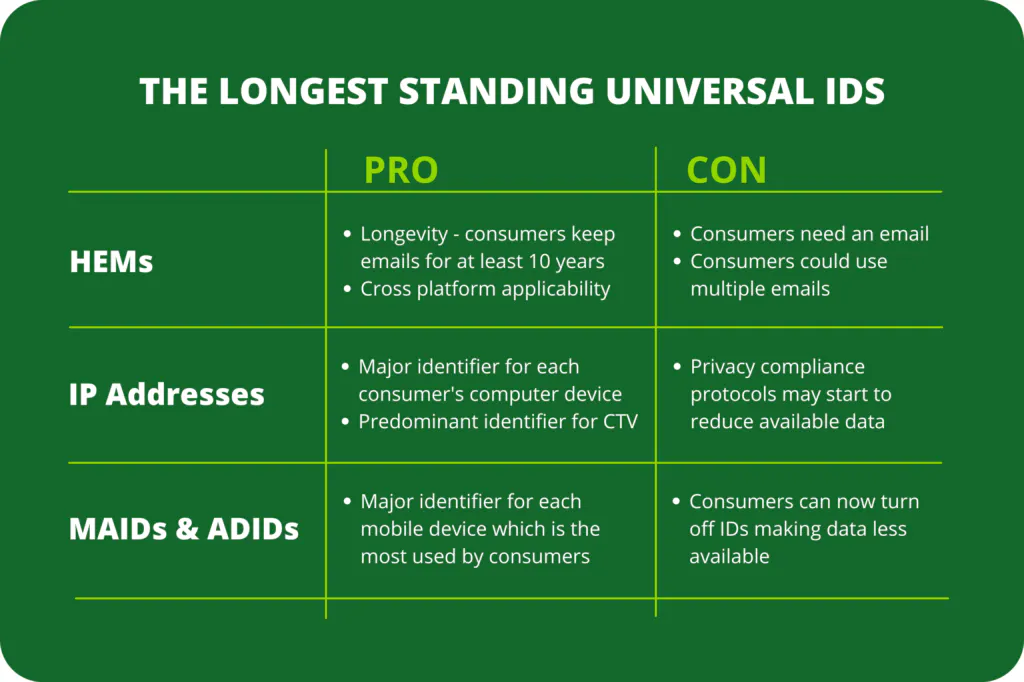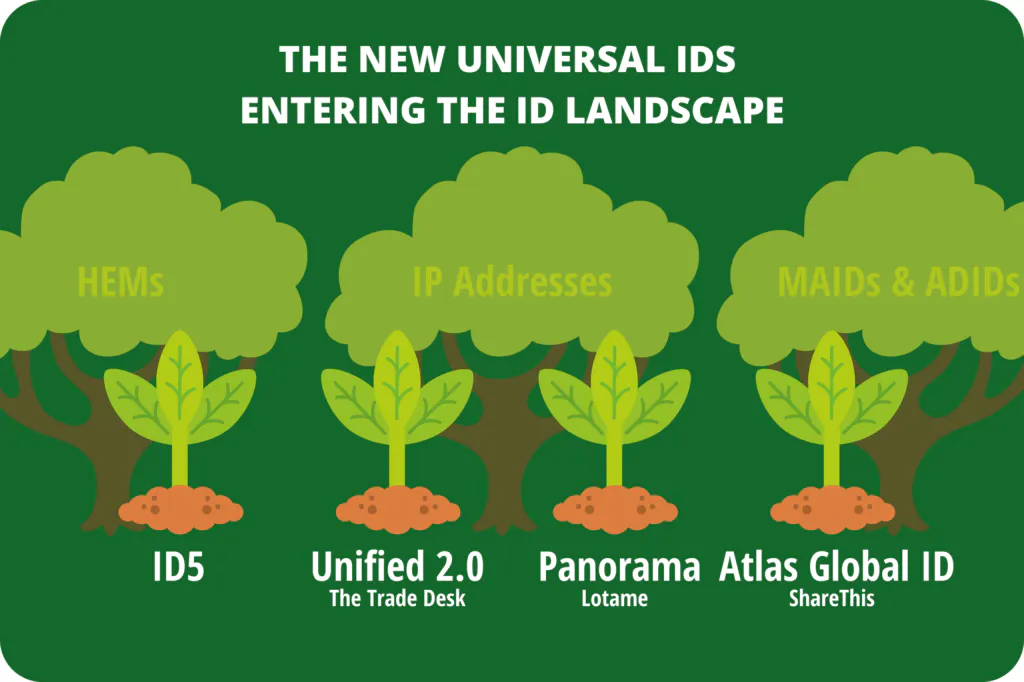As the world nears a cookieless future, a literal cornucopia of ID options is unfolding. From HEMS, IP addresses and MAIDS to FLoC, ID5, TTD and Panorama, it’s a world of acronyms, data clean rooms and empowered consumers. What’s a digital marketer to do? Fortunately, universal non-third-party ID options are growing. Understanding some of the pros and cons will empower your choices.
Universal IDs Go Beyond Cookies Like… Rockets Beat Bicycles
And here’s why. Universal IDs (UIDs) are pretty much what they sound like: persistent IDs, ala first-person cookies, stored in a user’s browser. But rather than relying on the HTTP-based cookie-synching process to ID users across domains or devices, UIDs are matched and synched using a wide mix of probabilistic and deterministic data. They can then be further modeled, giving you more targeting power across devices, platforms, locations and even emails.
As the industry races to add UIDs to data management platforms, marketers can only win. That’s because industry leaders are growing increasingly sophisticated in their ability to put UIDs to work for programmatic advertising and other digital marketing tactics. Allowing brands to identify and understand consumers in ways that drive authentic engagement and enthusiasm. So how do these UIDs work?
Diving into the Universal ID Multiverse
Some universal IDs and attributes, such as Hashed Emails (HEMS), IP addresses, and mobile ad IDs (MAIDs) or Android ad IDs (ADIDs), have been around a long time.
For example, cryptographic data hashing—such as that used to create HEMS—has been around pretty much as long as mankind has. Hashing, whether of emails, other online content or spoken words, is the action of reorganizing data elements to fit a given pattern that contains meaning for people or systems with the keys.
HEMs exist online, so their hashing uses a mathematical algorithm to convert the email to a bit value of a certain length. An analog comparison would be Pig Latin, where English-language speakers rearrange the sounds of words, rendering them incomprehensible to those who don’t know the Pig Latin rules.
What makes HEMs valuable as a UID is their longevity and cross-platform applicability. U.S. consumers, on average, keep their emails for at least 10 years and use them as logins and similar IDs for different sites—which all have their own unique IP address. Much of that browsing activity today, of course, happens on mobile devices, which include their own unique MAID or ADID. Matching all these IDs is becoming quite the rage. You could say it’s an abundance of matches made in heaven.
While these IDs work very well together, HEMS stand out from the rest. But, truly all of these IDs have some limitations. Here’s why:
- HEMs only work if you have a customer’s email, so they’re not great on their own for acquisition.
- IP addresses—CTV’s predominant identifier—are facing a future that looks very similar to that of third-party cookies. Google’s recently announced Gnatcatcher proposal to mask IP addresses joins an increasing number of privacy protocols designating device addresses as Personal Identifiable Information, or PII.
- MAIDs and ADIDs are useful as attributes for identity resolution and modeling; but since users can turn them off, they don’t make very reliable UIDs.
In fact, you could say that almost any identifier currently in use works well somewhere and sometimes. Just not all the time. Or everywhere marketers need them.
That’s Why a New Generation of UIDs Is Emerging
Imagine if the impossible were possible… your brand, or campaign, can sync and interpret vast amounts of attribute-rich data from multiple sources, across diverse sectors and locations, quickly, affordably and with high degrees of probability.
That’s what UIDs do. Cool, huh?
Here’s the thing. UIDs are technological solutions, created by high-tech companies that have and/or bring together different, large data sources for analysis. That analysis may be probabilistic, deterministic or a mix of both.
Deterministic analysis is based on identifiers with greater certainty such as log-on credentials and emails. Probabilistic analysis on the other hand is all about multiplicity. By combing through hundreds of signals from multiple devices and channels, probabilistic analysis can derive anonymous user profiles with behaviors similar to actual users.
While even the best companies that develop probabilistic IDs may boast 70-95% accuracy, compared to deterministic IDs, their advantage is the fact that they can be that accurate without massive amounts of deterministic data – which relatively few businesses actually have.
As Personal Identifiable Information (PII) becomes increasingly protected, the value of expert probabilistic analysis and graphing grows.
Leading ad tech solution providers are developing promising UID solutions—including ID5, Unified 2.0 by The Trade Desk, and Panorama by Lotame—all of which are interoperable with ShareThis Atlas ID and with growing coverage. Each of these players offers different options and uses proprietary algorithms, so choosing the right one really depends on what you need and which UID solution comes closest to meeting it. For example:
- Do you have good amounts of quality deterministic data that can speed matching?
- Or are you looking to leverage more probabilistic analyses to expand your market view?
- What parts of the globe matter most?
- What industries do you need to cover?
ID5 combines its history of expertise in ID matching and strong EU coverage and security, with a privacy-first focus in user recognition plus measurement capabilities. First steps involve integrating brand data with ID5 at no cost. Then, a range of solutions are available to address the needs of publishers, advertisers, supply- and demand-side platforms, while also ensuring data protection and results.
The Trade Desk’s Unified ID 2.0, strong in the US and likely to take a dominant market position, offers a different approach. Their solution is open source and interoperable, while also upgrading consumer privacy and transparency. TTD rotates encryption keys, enforces a code of conduct among all participants through regular audits, and offers consumers the ability to easily view and manage their preferences, including opting out at any time.
Panorama ID by Lotame, on the other hand, is a ‘privacy-first and people-based’ probabilistic identity solution for the open web, focusing heavily on unauthenticated signals along with mobile, CTV and customer data. Lotame’s VP Product Management, Pierre Diennet, believes that identity solutions relying on registered or email-identified customers likely leave 80% of the marketplace untapped. A range of solutions offer cross-platform audience analysis and modeling, as well as off-the-shelf segments suitable for planning, insights or activation. Plus, plain old identity resolution can help marketers scale campaign targeting and expand activation options, and other capabilities.
And while Google has put its FLoC effort on hold for the time being, its approach (as shared so far) hides individuals “in the crowd” and uses on-device processing to keep web history private on the browser.
Perhaps this cookieless future isn’t as scary as it first seemed. With enough data and enough technical power readily available, marketers are gaining more capabilities without cookies than they had before. Well, as they say… that’s just the way the cookie crumbles.
Takeaways
Universal identifiers are becoming available. And they’re working. The leaders include ID5.io, Unified 2.0 by The Trade Desk, Panorama by Lotame and others. Leveraging the power of the unauthenticated web, as well as first-party identifiers, in compliance with PII constraints is like… well, like having your desert and eating it too.






